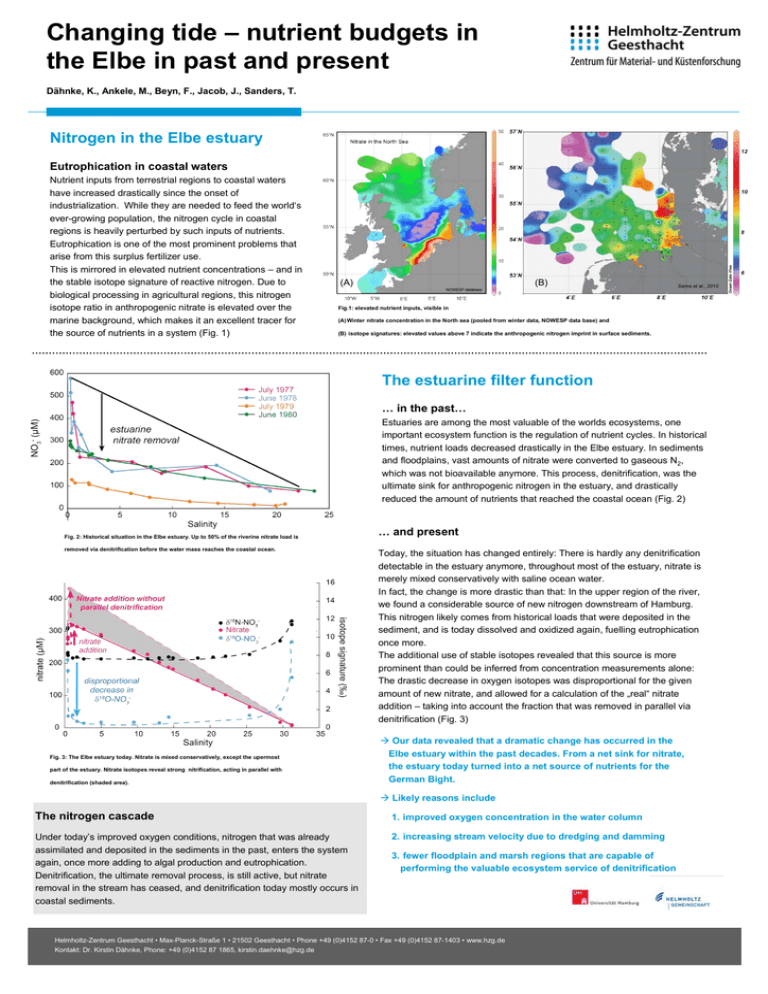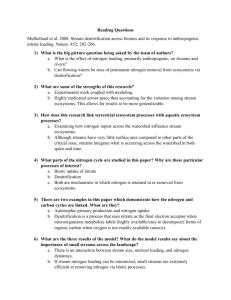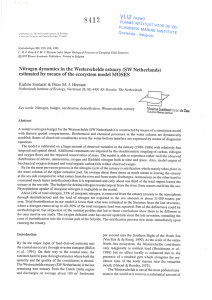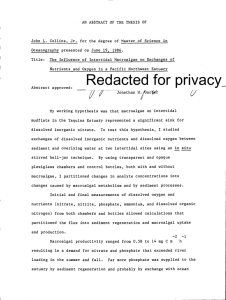Changing tide – nutrient budgets in Nitrogen in the Elbe estuary
advertisement

Changing tide – nutrient budgets in the Elbe in past and present Dähnke, K., Ankele, M., Beyn, F., Jacob, J., Sanders, T. Nitrogen in the Elbe estuary Eutrophication in coastal waters Nutrient inputs from terrestrial regions to coastal waters have increased drastically since the onset of industrialization. While they are needed to feed the world‘s ever-growing population, the nitrogen cycle in coastal regions is heavily perturbed by such inputs of nutrients. Eutrophication is one of the most prominent problems that arise from this surplus fertilizer use. This is mirrored in elevated nutrient concentrations – and in the stable isotope signature of reactive nitrogen. Due to biological processing in agricultural regions, this nitrogen isotope ratio in anthropogenic nitrate is elevated over the marine background, which makes it an excellent tracer for the source of nutrients in a system (Fig. 1) (A) (B) Serna et al., 2010 Fig.1: elevated nutrient inputs, visible in (A) Winter nitrate concentration in the North sea (pooled from winter data, NOWESP data base) and (B) isotope signatures: elevated values above 7 indicate the anthropogenic nitrogen imprint in surface sediments. The estuarine filter function … in the past… Estuaries are among the most valuable of the worlds ecosystems, one important ecosystem function is the regulation of nutrient cycles. In historical times, nutrient loads decreased drastically in the Elbe estuary. In sediments and floodplains, vast amounts of nitrate were converted to gaseous N2, which was not bioavailable anymore. This process, denitrification, was the ultimate sink for anthropogenic nitrogen in the estuary, and drastically reduced the amount of nutrients that reached the coastal ocean (Fig. 2) Fig. 2: Historical situation in the Elbe estuary. Up to 50% of the riverine nitrate load is removed via denitrification before the water mass reaches the coastal ocean. Fig. 3: The Elbe estuary today. Nitrate is mixed conservatively, except the upermost part of the estuary. Nitrate isotopes reveal strong nitrification, acting in parallel with denitrification (shaded area). … and present Today, the situation has changed entirely: There is hardly any denitrification detectable in the estuary anymore, throughout most of the estuary, nitrate is merely mixed conservatively with saline ocean water. In fact, the change is more drastic than that: In the upper region of the river, we found a considerable source of new nitrogen downstream of Hamburg. This nitrogen likely comes from historical loads that were deposited in the sediment, and is today dissolved and oxidized again, fuelling eutrophication once more. The additional use of stable isotopes revealed that this source is more prominent than could be inferred from concentration measurements alone: The drastic decrease in oxygen isotopes was disproportional for the given amount of new nitrate, and allowed for a calculation of the „real“ nitrate addition – taking into account the fraction that was removed in parallel via denitrification (Fig. 3) Our data revealed that a dramatic change has occurred in the Elbe estuary within the past decades. From a net sink for nitrate, the estuary today turned into a net source of nutrients for the German Bight. Likely reasons include The nitrogen cascade 1. improved oxygen concentration in the water column Under today’s improved oxygen conditions, nitrogen that was already assimilated and deposited in the sediments in the past, enters the system again, once more adding to algal production and eutrophication. Denitrification, the ultimate removal process, is still active, but nitrate removal in the stream has ceased, and denitrification today mostly occurs in coastal sediments. 2. increasing stream velocity due to dredging and damming 3. fewer floodplain and marsh regions that are capable of performing the valuable ecosystem service of denitrification Helmholtz-Zentrum Geesthacht • Max-Planck-Straße 1 • 21502 Geesthacht • Phone +49 (0)4152 87-0 • Fax +49 (0)4152 87-1403 • www.hzg.de Kontakt: Dr. Kirstin Dähnke, Phone: +49 (0)4152 87 1865, kirstin.daehnke@hzg.de










